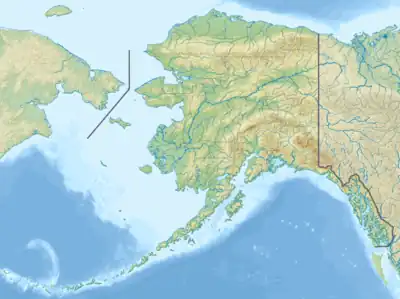| Mount Fellows | |
|---|---|
 West aspect | |
| Highest point | |
| Elevation | 4,476 ft (1,364 m)[1][2] |
| Prominence | 726 ft (221 m)[3] |
| Parent peak | Sugar Loaf Mountain[4] |
| Isolation | 1.65 mi (2.66 km)[3] |
| Coordinates | 63°42′29″N 148°45′08″W / 63.7079969°N 148.7521688°W[5] |
| Geography | |
 Mount Fellows Location of Mount Fellows in Alaska | |
| Country | United States |
| State | Alaska |
| Borough | Denali |
| Parent range | Alaska Range |
| Topo map | USGS Healy C-4 |
| Geology | |
| Type of rock | Volcanic rock[6] |
Mount Fellows is a 4,476-foot-elevation (1,364-meter) mountain summit in Alaska, United States.
Description
Mount Fellows is located five miles (8.0 km) east of Denali National Park headquarters and 8.25 miles (13.28 km) northwest of Pyramid Mountain in the Alaska Range.[5] Precipitation runoff from the mountain drains into tributaries of the Nenana River, which in turn is part of the Tanana River drainage basin. Although modest in elevation, topographic relief is significant as the summit rises over 2,800 feet (914 m) above the Nenana River in 1.75 miles (2.82 km). The mountain's name was reported in 1950 by the USGS,[1] and the toponym has been officially adopted by the United States Board on Geographic Names.[5]
Climate
Based on the Köppen climate classification, Mount Fellows is located in a subarctic climate zone with long, cold, snowy winters, and mild summers.[7] Winter temperatures can drop below 0 °F with wind chill factors below −20 °F. The months May through June offer the most favorable weather for viewing.
See also
References
- 1 2 Donald J. Orth, Dictionary of Alaska Place Names, U.S. Government Printing Office, 1967, page 330.
- ↑ Guide to Scenic Highways & Byways, National Geographic Books, 2007, ISBN 9781426210143, p. 383.
- 1 2 "Fellows, Mount - 4,476' AK". listsofjohn.com. Retrieved 2024-01-03.
- ↑ "Mount Fellows, Peakvisor.com". Retrieved 2024-01-03.
- 1 2 3 "Mount Fellows". Geographic Names Information System. United States Geological Survey, United States Department of the Interior. Retrieved 2024-01-03.
- ↑ The United States Geological Survey in Alaska: Accomplishments during 1981, 1984. p. 80.
- ↑ Peel, M. C.; Finlayson, B. L.; McMahon, T. A. (2007). "Updated world map of the Köppen−Geiger climate classification". Hydrol. Earth Syst. Sci. 11. ISSN 1027-5606.
External links
- Weather forecast: Mount Fellows
- Mount Fellows (photo): Flickr